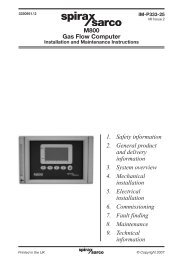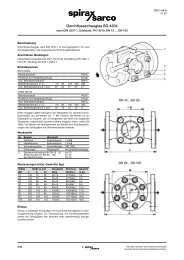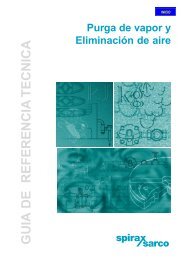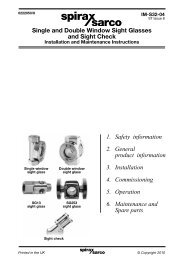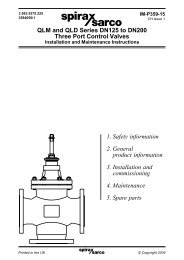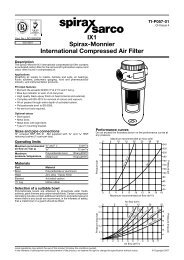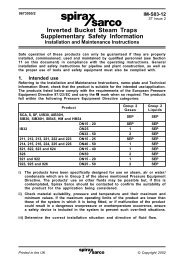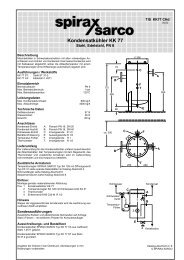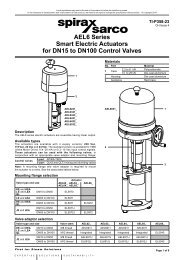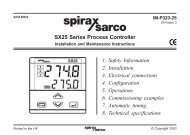2000 Hook-up Book - Spirax Sarco
2000 Hook-up Book - Spirax Sarco
2000 Hook-up Book - Spirax Sarco
Create successful ePaper yourself
Turn your PDF publications into a flip-book with our unique Google optimized e-Paper software.
SYSTEM DESIGN<br />
46<br />
Condensate Recovery Systems<br />
have been sized using water volume<br />
only and did not include the<br />
flash steam volume that is present.<br />
The specific volume of water<br />
at 0 psig is .017 cubic feet per<br />
pound, compared to 26.8 cubic<br />
feet per pound for flash steam at<br />
the same pressure. Sizing of condensate<br />
return lines from trap<br />
discharges based totally on water<br />
is a gross error and causes lines<br />
to be drastically undersized for<br />
the flash steam. This causes condensate<br />
lines to become<br />
pressurized, not atmospheric,<br />
which in turn causes a backpressure<br />
to be applied to the trap’s<br />
discharge which can cause<br />
equipment failure and flooding.<br />
This undersizing explains<br />
why the majority of 0 psi atmospheric<br />
condensate return<br />
systems in the United States do<br />
not operate at 0 psig. To take this<br />
thought one step further for those<br />
people who perform temperature<br />
tests on steam traps to determine<br />
if the trap has failed, the instant<br />
we cause a positive pressure to<br />
develop in the condensate return<br />
system by flash steam, the condensate<br />
return line now must<br />
follow the pressure/temperature<br />
relationship of saturated steam.<br />
So, trap testing by temperature<br />
identifies only that we have a<br />
return system at a certain temperature<br />
above 212°F (0 psig)<br />
and we can then determine by<br />
that temperature the system<br />
pressure at which it is operating.<br />
Elevated condensate return temperatures<br />
do not necessarily<br />
mean a trap has failed.<br />
When sizing condensate<br />
return lines, the volume of the<br />
flash steam must be given due<br />
consideration. The chart at Fig.<br />
51 (page 43) allows the lines to<br />
be sized as flash steam lines—<br />
since the volume of the<br />
condensate is so much less than<br />
that of the steam released.<br />
Draining condensate from<br />
traps serving loads at differing<br />
pressures to a common condensate<br />
return line is a concept<br />
which many find difficult. It is<br />
often assumed that the HP “high<br />
pressure” condensate will prevent<br />
the “low pressure” condensate<br />
from passing through the LP<br />
traps and give rise to waterlogging<br />
of the LP system.<br />
However, the terms HP and<br />
LP can only apply to the conditions<br />
on the <strong>up</strong>stream side of the<br />
seats in the traps. At the downstream<br />
or outlet side of the traps,<br />
the pressure must be the common<br />
pressure in the return line.<br />
This return line pressure will be<br />
the sum of at least three components:<br />
1. The pressure at the end of<br />
the return line, either atmospheric<br />
or of the vessel into<br />
which the line discharges.<br />
2. The hydrostatic head needed<br />
to lift the condensate <strong>up</strong> any<br />
risers in the line.<br />
3. The pressure drop needed to<br />
carry the condensate and<br />
any flash steam along the<br />
line.<br />
Item 3 is the only one likely to<br />
give rise to any problems if condensate<br />
from sources at different<br />
pressures enters a common line.<br />
The return should be sufficiently<br />
large to carry all the liquid condensate<br />
and the varying amounts<br />
of flash steam associated with it,<br />
without requiring excessive line<br />
velocity and excessive pressure<br />
drop. If this is accepted, the total<br />
return line cross sectional area<br />
will be the same, whether a single<br />
line is used, or if two or more lines<br />
are fitted, with each taking the<br />
condensate from a single pressure<br />
source.<br />
The return could become<br />
undersized, requiring a high pressure<br />
at the trap discharges and<br />
restricting or preventing discharge<br />
from the LP traps, if it is<br />
forgotten that the pipe has to<br />
carry flash steam as well as water<br />
and that flash steam is released<br />
in appreciable quantity from HP<br />
condensate.<br />
While the percentage, by<br />
weight, of flash steam may be<br />
rather low, its overall volume in<br />
comparison to the liquid is very<br />
large. By determining the quantity<br />
of flash steam and sizing the<br />
return line for velocities between<br />
4,000 and 6,000 ft/min, the twophase<br />
flow within the pipe can be<br />
accommodated. The information<br />
required for sizing is the condensate<br />
load in lb/h, inlet pressure to<br />
steam trap(s) in psig and return<br />
line system pressure.<br />
Example:<br />
Size a condensate return line<br />
from a 160 psig steam trap discharging<br />
to 20 psig. flash tank.<br />
Load is 3,000 lb/h.<br />
1. Determine percent flash<br />
steam produced using Table<br />
12 (page 41). With a steam<br />
pressure of 160 psig and a<br />
flash tank pressure of 20 psig<br />
read a value of 12.4%.<br />
2. Next, multiply the condensate<br />
load by the percent flash from<br />
step #1 to determine the<br />
flowrate, of flash steam produced.<br />
3,000 lb/h x .124 = 372 lb/h.<br />
3. Enter Fig. 51 (page 43) at the<br />
flash steam flowrate of 372<br />
lb/h at “A” and move horizontally<br />
to the right to the flash<br />
tank pressure of 20 psig “B”.<br />
Rise vertically to choose a<br />
condensate return line size<br />
which will give a velocity<br />
between 4,000 and 6,000<br />
ft/min, “C”. In this example, an<br />
1-1/2” schedule 40 pipe with<br />
a velocity of approximately<br />
5,000 ft/min. If schedule 80<br />
pipe is to be used, refer to<br />
table within body of chart.<br />
Multiply the velocity by the<br />
factor to determine whether<br />
the velocity is within acceptable<br />
limits.



